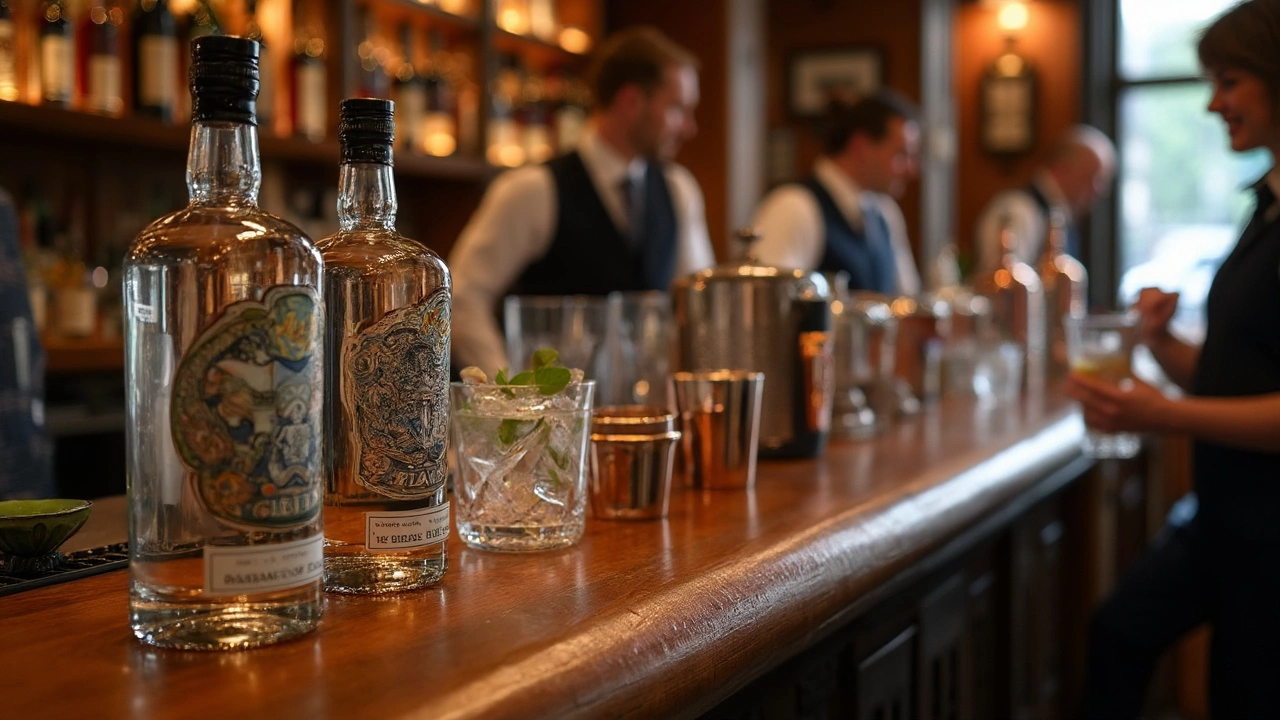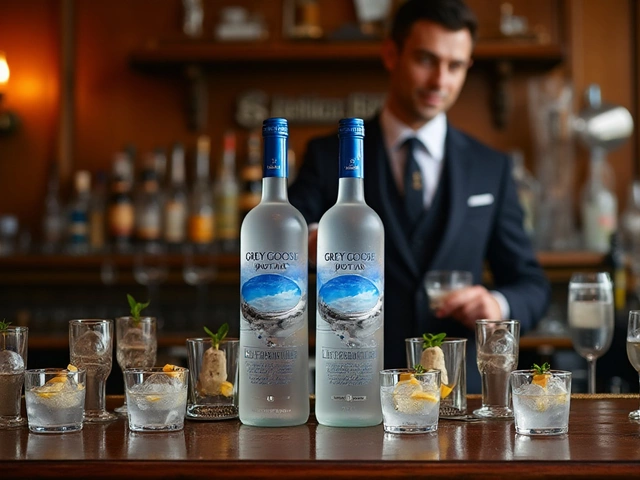Ever stood in the gin aisle and wondered what 'top shelf' actually means? It's not just a fancy way of saying expensive. With gin, 'top shelf' is about the whole package: the quality of the botanicals, how the spirit is made, the attention to detail, and honestly, the taste that makes you go 'wow' with that first sip. People chase these bottles for a reason—they deliver an experience you won’t forget.
Thinking about going on a gin distillery tour? Smart move. It’s the perfect chance to see first-hand what goes into these high-end bottles, talk to the folks who actually make the stuff, and figure out what really sets a top shelf gin apart. Sniffing and sipping your way through the distillery beats guessing at the store—plus, you’ll leave knowing exactly what to look for next time.
- The Real Meaning of 'Top Shelf' Gin
- Signature Brands That Earn Their Spot
- What Sets Premium Gin Apart at the Distillery
- Tips for Savoring Top Shelf Gin on Your Tour
The Real Meaning of 'Top Shelf' Gin
So, what puts a gin bottle on the top shelf? First off, it’s not just the price tag or a slick label. If a gin is called 'top shelf,' it’s because of what’s inside: top-notch ingredients, tight control over the making process, and a flavor that actually stands out.
Most major players use way more than just juniper. They pick unique botanicals—stuff like wild foraged herbs, rare fruits, and even flowers. These aren’t just for show, either. They give the gin its punch, aroma, and finish. Anyone can add flavor, but it takes skill to balance them so they don’t clash or taste artificial.
- Top shelf gin usually starts with a neutral spirit distilled multiple times. This takes out funky flavors and makes the base super smooth.
- Dilution matters too: the spring water or filtered water they use can really lift a gin up a notch.
- Some makers use small batches. This is less efficient but lets them keep a closer eye on quality every single time they run a distillation.
- You’ll often see higher alcohol content—sometimes 44% ABV or even higher. It sounds like a lot, but it makes the flavors pop (and stands up to tonic without getting drowned out).
Name-dropping time: Tanqueray No. TEN, Sipsmith VJOP, and Monkey 47 are all safe bets for top shelf. Each has a list of botanicals the size of my dog’s wish list—sometimes more than 40, like Monkey 47, which goes wild with everything from lingonberries to spruce.
| Brand | Notable Botanicals | Distillation Method | Avg. ABV (%) |
|---|---|---|---|
| Monkey 47 | Lingonberry, spruce, citrus | Small batch, copper stills | 47 |
| Sipsmith VJOP | Juniper heavy, coriander | Pot still | 57.7 |
| Tanqueray No. TEN | Fresh citrus, chamomile | Small batch, fresh botanicals | 47.3 |
If you take one thing from this, it’s that top shelf isn’t hype. These bottles earn their place by doing the details right, every single batch, from picking the best botanicals to fine-tuning every step in the distillery.
Signature Brands That Earn Their Spot
Some gins just have that reputation. You see the bottle, and yep, it’s what people reach for when they want to feel fancy or impress someone at home. But which ones actually live up to the hype? I’m talking about more than just a shiny label; I mean the names most bartenders and gin lovers swear by again and again.
Let’s start with the classics everyone should know:
- Hendrick’s: This Scottish gin changed the game. People love it for its oddball mix of cucumber and rose, making cocktails taste clean and crisp. You can find it in pretty much every solid cocktail bar around the world.
- Tanqueray No. Ten: This gin is built for cocktails, especially martinis. It uses whole citrus fruits in the mix and keeps winning tasting awards year after year. If you see it on a tour list, don’t skip it.
- The Botanist: Made on the tiny Isle of Islay, Scotland, The Botanist packs 22 local botanicals for crazy fresh flavor. It’s a must-try if you want something unique, and most distillery tours on Islay let you see how it’s made up close.
- Sipsmith: Based in London, Sipsmith started the whole UK craft gin revolution. These guys fought to change British law just to start making small-batch gin. Their London Dry is loaded with classic juniper punch.
- Monkey 47: This German gin blows people away with its mashup of 47 botanicals (yes, for real). You’ll taste everything from cranberries to spruce, and each sip is a little different. It’s pricy but totally delivers when you want something special.
Here’s how a few of these top shelf gins stack up on flavor, ABV, and a rough average price:
| Brand | Signature Botanicals | ABV (%) | Average Price (USD) |
|---|---|---|---|
| Hendrick’s | Cucumber, Rose | 41.4 | $38 |
| Tanqueray No. Ten | Citrus, Chamomile | 47.3 | $38 |
| The Botanist | 22 Local Botanicals | 46 | $42 |
| Sipsmith | Juniper, Lemon Peel | 41.6 | $30 |
| Monkey 47 | 47 Botanicals | 47 | $75 |
Sure, you’ll spot other bottles on shelves claiming ‘premium’ or ‘craft,’ but not all are worth your cash. Stick to these legends, especially when you’re touring and tasting. If you get a chance, ask your tour guide for samples of limited editions or small-batch runs, too—sometimes the really good stuff never even makes it to regular store shelves.

What Sets Premium Gin Apart at the Distillery
The secret sauce behind a true top shelf gin comes down to what happens inside the distillery. Not all bottles are made equal—just touring a few places and talking to their teams makes that crystal clear. Experienced gin makers obsess over every step, from picking their botanicals to the final blend. Want to know what separates the premium from the average? Here’s what you’ll spot during a distillery visit:
- Botanical Selection: Top distilleries hand-pick each herb, root, and spice. We’re talking juniper berries sourced from Tuscany, Sicilian lemons, Persian angelica root, and more. Some brands use up to 30 different botanicals to get that layered flavor.
- Water Quality: The water isn’t just a filler. Trustworthy places like Tanqueray and Sipsmith only use pure spring or filtered water for crispness that actually shows up when you take a sip.
- Distillation Method: Small-batch copper pot stills, slow distillation, and constant tasting at every stage—it’s a craft. Some distilleries run their gin through the still multiple times just for a smoother finish.
- Resting and Blending: After distilling, the gin often gets a rest to let flavors meld. Then comes the blending, balancing all the herbal notes and heat from the alcohol so it’s just right, not overpowering.
Distillery workers will usually show you the difference in gins made quickly and cheaply versus their careful process. The numbers prove why extra steps matter:
| Gin Type | Average Price (USD) | Number of Botanicals | Distillation Time |
|---|---|---|---|
| Chemical/Industrial | ~$10-20 | 3-6 | 4-8 hours |
| Craft/Small-batch | $40+ | 10-30 | 12-30 hours |
When you tour a distillery focused on top shelf gin, you’re going to see a higher level of care, pride, and transparency. If they geek out over their blending tanks and let you sniff different botanicals or sample straight from the still, you're in a good spot. The details matter because you taste every single one in your glass.
Tips for Savoring Top Shelf Gin on Your Tour
If you're shelling out for a tour at a serious gin distillery, you want to make it count. Whether it's your first time or you already know your way around tonic, these tips will help you get the best out of every tasting and walk away knowing just what sets a top shelf gin apart from the rest.
- Start with your nose. Before you even taste, give the gin a smell. There’s more going on than just juniper—look out for hints of citrus, spices, or even florals if you're sampling London Dry or craft gins like Hendrick’s or Monkey 47. Don’t stick your nose right in the glass—hold it back an inch or so and take a slow sniff.
- Don’t knock it back—sip it slowly. Neat gin can hit hard, especially with higher-end bottles that often have a punchier flavor. Take tiny sips so you can actually taste the botanicals instead of just booze. If the burn is too much, a couple drops of water open up the flavor (kind of like whisky).
- Compare side by side. Most tours will offer a tasting flight. If you get the chance, taste a basic gin before moving to the premium stuff. Notice which flavors pop more. Stats show people notice twice as many botanical notes when they try gins in a row, rather than one at a time.
- Ask questions like you mean it. Distillers love talking shop. Ask about the stills, how long they rest their gin, or what wild botanicals they’ve used. You’ll usually hear answers you never find on the back label—like which batch had a weird lemon harvest or what water source they swear by.
- Try it the local way. If you’re in a place like Plymouth or Edinburgh, chances are the distillery knows the best tonic or garnish pairings for their gin. Don’t be shy—if they say try it with a rosemary sprig or grapefruit, trust them and give it a shot.
- Mix and match responsibly. A tasting doesn’t mean you need to finish every glass. Jot quick tasting notes or snap a picture of your favorites if you think you’ll forget. And trust your own taste—it’s not a contest to see who likes the rarest or most expensive gin.
| Feature | Basic Gin | Top Shelf Gin |
|---|---|---|
| Botanicals | Usually 3-7, often juniper and citrus | Often 10-47, wild or rare ingredients |
| Mouthfeel | Sharper, sometimes harsh | Smoother, creamy or soft finish |
| Finish | Short, sometimes bitter | Long, layered, evolving flavors |
| Recommended Serve | Basic tonic, lime | Specific garnish, craft tonic, neat or martini |
Big tip I picked up at a distillery in 2022: drink some water between each tasting round. It resets your palate, so every gin gets a fair shot. And if you’re visiting with friends, compare notes—it's hilarious how different your tasting impressions turn out. You’ll end up learning way more about what you (and your crew) really like.


